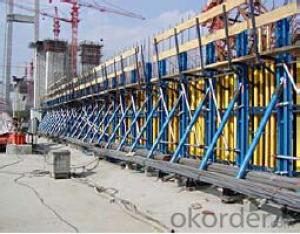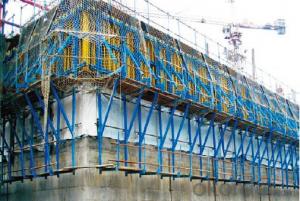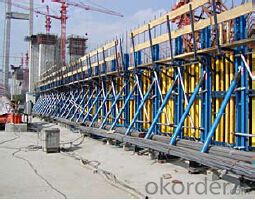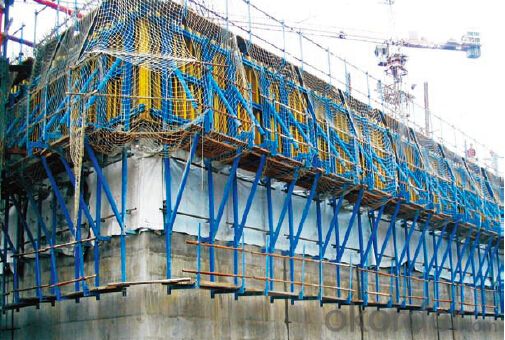Single side climbing bracket for formwork and scaffolding systems
- Loading Port:
- Tianjin
- Payment Terms:
- TT OR LC
- Min Order Qty:
- 50 m²
- Supply Capability:
- 1000 m²/month
OKorder Service Pledge
OKorder Financial Service
You Might Also Like
Single-side Climbing Bracket SCB180:
With CNBM SCB 180 climbing systems, the loads from the fresh concrete pressure are
transferred through the brackets by means of V-strongbacks and compression braces into the
scaffold anchors.
Typical applications for the SCB 180 are dams, locks, cooling towers, pier heads, tunnels, and
bank vaults.
The formwork is simply tilted backwards when striking takes place. The 1.80 m wide bracket
requires only a minimum of space.
Characteristics:
◆ Economical and safe anchoring
The M30/D20 climbing cones have been designed especially for single-sided concreting using
SCB180 in dam construction, and to allow the transfer of high tensile and shear forces into the still
fresh, unreinforced concrete. Without wall-through tie-rods, finished concrete is perfect.
◆ Stable and cost-effective for high loads
generous bracket spacings allow large-area formwork units with optimal utilization of the bearing
capacity. This leads to extremely economical solutions.
◆ Simple and flexible planning
With SCB180 single-sided climbing formwork, circular structures can also be concreted without
undergoing any large planning process. Even use on inclined walls is feasible without any special
measures because additional concrete loads or lifting forces can be safely transferred into the
structure.
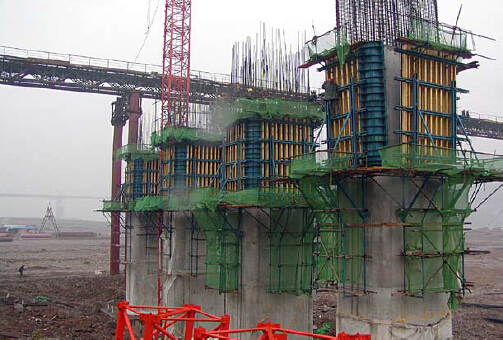
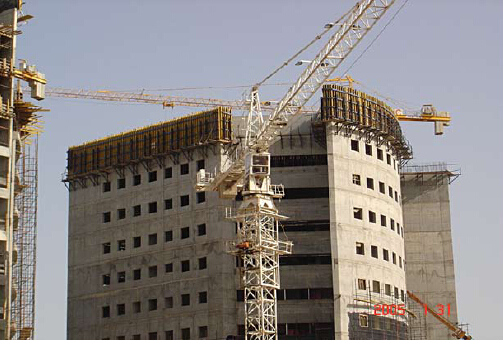
- Q: Can steel formwork be used for pier caps?
- Certainly! Pier caps can indeed be constructed using steel formwork. Steel formwork presents numerous benefits, including its exceptional strength, durability, and ability to be reused. By utilizing steel formwork, a flawless and accurate finish can be achieved for the pier caps, guaranteeing a superior final outcome. Moreover, the assembly and disassembly of steel formwork is a straightforward task, facilitating efficient construction procedures. Consequently, steel formwork emerges as a fitting option for the creation of pier caps, as it supplies the essential support and structural integrity indispensable in this particular undertaking.
- Q: Can steel formwork be used for structures with high impact resistance requirements?
- Yes, steel formwork can be used for structures with high impact resistance requirements. Steel is known for its strength and durability, making it suitable for withstanding high impact loads. It has a high strength-to-weight ratio, providing excellent resistance against impact forces. Steel formwork systems are commonly used in construction projects that require structures to withstand heavy loads or potential impacts, such as bridges, tunnels, and high-rise buildings. Additionally, steel formwork can be easily fabricated and assembled, allowing for quick and efficient construction of structures with high impact resistance requirements.
- Q: How does steel formwork compare to plastic formwork?
- Steel formwork is generally more durable and long-lasting compared to plastic formwork. It can withstand heavy loads and provides better stability and support during the concrete pouring process. Additionally, steel formwork is reusable and can be easily adjusted and customized according to project requirements. On the other hand, plastic formwork is lighter and easier to handle, making it more suitable for small-scale projects. However, it may not be as sturdy and may require more frequent replacements.
- Q: How does steel formwork affect the overall material wastage in construction?
- Steel formwork can greatly reduce material wastage in construction projects. Unlike traditional timber formwork, which is often single-use and needs to be discarded after each use, steel formwork is reusable and can be used multiple times. This significantly reduces the need for new materials, such as timber, plywood, or plastic, which would otherwise contribute to material wastage. Additionally, steel formwork is highly durable and can withstand harsh weather conditions, impacts, and vibrations. This durability ensures that the formwork remains intact and functional for a longer period, reducing the need for frequent replacements and further minimizing material wastage. Moreover, steel formwork is highly customizable and can be easily adjusted and modified to fit different project requirements. This flexibility allows for precise shaping and molding of concrete structures, resulting in reduced material wastage. With timber formwork, achieving complex shapes or curves can be challenging and may lead to excessive cutting and wastage. Furthermore, steel formwork offers excellent dimensional stability, ensuring accurate and consistent concrete placement. This eliminates the need for rework, which can result in material wastage. Additionally, steel formwork provides a smooth surface finish, reducing the requirement for additional finishing materials, such as plaster, which again minimizes material wastage. Overall, the use of steel formwork in construction projects can significantly reduce material wastage. Its reusability, durability, flexibility, dimensional stability, and smooth surface finish contribute to optimizing material usage, minimizing the need for new materials, and ultimately reducing overall material wastage.
- Q: How does steel formwork handle concrete bleeding and segregation?
- Steel formwork has a reputation for effectively managing concrete bleeding and segregation. Bleeding occurs when water in the concrete mixture rises to the surface, leaving a layer of water on top. Segregation, on the other hand, happens when the solid particles in the concrete mixture separate from the water, causing an uneven distribution. To minimize bleeding and segregation, steel formwork provides a sturdy structure that holds the concrete in place during pouring and curing. The strong construction and tight joints of steel formwork prevent any leaks or seepage, resulting in reduced bleeding. Moreover, steel formwork allows for better control over the placement and compaction of the concrete. The smooth and non-absorbent surface of steel formwork facilitates a uniform distribution of the concrete mixture, minimizing the risk of segregation. Additionally, using steel formwork enables proper vibration and consolidation of the concrete, eliminating any voids or air pockets that could contribute to segregation. Furthermore, steel formwork ensures stability during the curing process, preventing significant movement of the concrete. This stability helps avoid disturbances that could lead to bleeding or segregation. In conclusion, steel formwork is highly effective in managing concrete bleeding and segregation due to its rigid structure, tight joints, smooth surface, and stability. Its use promotes a more consistent and consolidated placement of concrete, resulting in a higher quality finished product.
- Q: Steel formwork in the construction project, after the completion of concrete pouring, the wall surface from the powder seriously how to deal with?
- This is no problem with the steel template, the ratio of concrete problems!
- Q: What are the different types of steel formwork systems available in the market?
- In the market, one can find a variety of steel formwork systems that cater to specific construction needs and requirements. 1. The most commonly used steel formwork system in construction projects is the traditional steel formwork. It involves assembling steel plates and angles to create a temporary mold for concrete placement. This type of formwork is versatile and suitable for various structures. 2. Another type is the modular steel formwork system, which comprises pre-made modular panels that interconnect to form a mold for concrete placement. It is lightweight, easy to assemble and disassemble, and can be reused multiple times, making it cost-effective and time-efficient. 3. For tunnel and underground structure construction, tunnel formwork systems are designed. They utilize steel plates assembled to create a continuous mold along the tunnel's length. These systems are durable, capable of withstanding high pressures, and provide a smooth finish for the tunnel walls. 4. Climbing formwork systems are commonly used in high-rise construction projects. They feature a self-climbing mechanism that allows the formwork to be vertically raised or lowered as the construction progresses. By eliminating the need for cranes or external support, these systems are efficient and safe. 5. Slip formwork systems are employed for tall and slender structures like towers and chimneys. They involve a continuously moving formwork that is raised vertically as the concrete hardens. These systems ensure a smooth and uniform finish while being highly efficient for large-scale construction projects. These examples demonstrate the variety of steel formwork systems available in the market. The selection of a system depends on factors such as the type of structure, project timeline, budget, and specific construction requirements. It is crucial to consult with experts and consider these factors before choosing the most suitable steel formwork system for a project.
- Q: How does steel formwork handle different concrete pumping methods?
- Steel formwork offers a versatile and long-lasting solution for managing different concrete pumping methods. It is specifically designed to endure the pressure and force exerted during the pumping process, making it suitable for a range of pumping techniques. One widely used concrete pumping method involves the use of boom pumps, which employ a flexible or telescopic boom to reach the desired location. Steel formwork easily accommodates this method by providing a stable and secure surface for the boom pump to rest on. The strength and rigidity of steel ensure that the formwork remains intact and can withstand the weight and vibrations generated by the pumping process. Another popular pumping method is line pumping, which relies on a series of pipes and hoses to transport concrete to the intended location. Steel formwork is compatible with this method as well, as the pipes and hoses can be securely fastened to the formwork using clamps or brackets. The formwork acts as a support system for the pipes, ensuring they stay in place and can effectively transport the concrete without any disruptions. Furthermore, steel formwork can accommodate other concrete pumping methods like trailer-mounted pumps or truck-mounted pumps. These methods involve the use of portable pumps that can be easily moved to different locations. Steel formwork can be conveniently repositioned or adjusted to cater to the pump, providing a stable and dependable platform for the pumping process. In conclusion, steel formwork is a suitable choice for managing different concrete pumping methods due to its strength, stability, and adaptability. It effectively supports the equipment used in various pumping techniques, resulting in a seamless and efficient concrete placement process.
- Q: How does steel formwork impact the overall project execution?
- Steel formwork has a significant impact on the overall project execution in several ways. Firstly, steel formwork is known for its durability and strength, making it suitable for use in various construction projects. Its robust nature allows for multiple reuses, reducing the need for frequent replacements and lowering project costs. Additionally, steel formwork offers a high level of accuracy and precision in creating the desired shape and dimensions of concrete structures. This ensures that the final product meets the design specifications and minimizes any potential errors or defects. The ability to achieve precise and consistent results helps to streamline the construction process, saving time and effort. Furthermore, steel formwork provides excellent support and stability during the pouring and curing of concrete. Its rigid structure helps to prevent any deformation or displacement, ensuring that the concrete sets evenly and securely. This results in a structurally sound and stable finished product, enhancing the overall quality of the project. Moreover, steel formwork is versatile and adaptable, allowing for efficient customization to meet specific project requirements. It can be easily modified or adjusted to accommodate various shapes, sizes, and complexities of concrete structures. This flexibility enables contractors to work on projects with varying design specifications, reducing the need for multiple formwork systems and enhancing project efficiency. Lastly, steel formwork offers improved safety on construction sites. Its sturdy construction provides a stable working platform for workers, reducing the risk of accidents or injuries. Additionally, the use of steel formwork often requires fewer construction joints, resulting in a smoother and safer working environment. In conclusion, steel formwork plays a crucial role in the overall project execution by providing durability, accuracy, stability, versatility, and safety. Its impact extends beyond the construction phase, contributing to the long-term quality and success of the project.
- Q: How does steel formwork affect the overall construction site dust control?
- Steel formwork can have a positive impact on overall construction site dust control. Compared to other types of formwork, such as wooden or plastic, steel formwork is more durable and less likely to wear down or break, which can generate dust particles. This means that there will be less dust generated during the construction process. Additionally, steel formwork is typically designed to fit tightly together, reducing the gaps and spaces where dust can accumulate. This results in a cleaner and more controlled construction site environment, as there will be fewer areas for dust to settle and become airborne. Furthermore, steel formwork can be reused multiple times, which reduces the need for frequent replacements. This minimizes the amount of waste generated, including dust-producing debris from formwork removal and replacement. Overall, the use of steel formwork contributes to better dust control on construction sites, promoting a safer and healthier work environment for workers and reducing the potential negative impacts of dust on nearby communities and the environment.
Send your message to us
Single side climbing bracket for formwork and scaffolding systems
- Loading Port:
- Tianjin
- Payment Terms:
- TT OR LC
- Min Order Qty:
- 50 m²
- Supply Capability:
- 1000 m²/month
OKorder Service Pledge
OKorder Financial Service
Similar products
Hot products
Hot Searches
